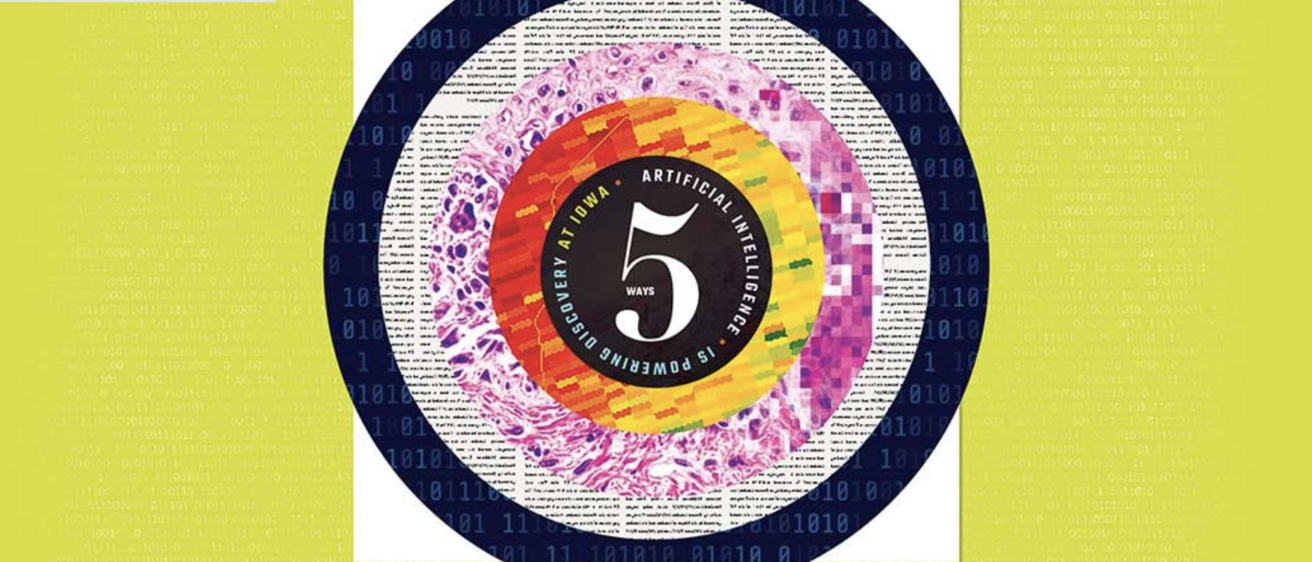From forecasting floods to fighting cancer, Iowa researchers are deploying AI to tackle some of society's biggest issues.
Imagine a father walking down the sidewalk with a wide-eyed toddler who's taken an interest in cars for the first time. The dad points out the different types of vehicles as they whiz by. "That's a sports car," the man says. "There's a pickup truck."
After a while, the boy begins to understand what's important in differentiating one type of vehicle from the next. The father doesn't need to tell the boy that a vehicle's color is irrelevant, but its size will help you tell the difference between a sedan and SUV. Instead, the dad simply points out more and more types of vehicles, and the boy soon begins to identify them on his own. "A truck!" he says.
Milan Sonka, University of Iowa professor of electrical and computer engineering, uses this analogy to explain how artificial intelligence processes new data like humans to solve problems. Traditionally, to train a computer to distinguish one type of vehicle from another, a programmer would code the specific traits to look for: the number of doors or the shape of the vehicle, for instance. But thanks to advancements in big data, computational power, and precision sensors, today's AI-powered computers can make these connections on their own using sophisticated algorithms. Like a toddler's growing brain, an AI program can learn to recognize complex patterns and solve high-level problems that traditional scientific approaches would be unable to unlock.
Like a toddler's growing brain, an AI program can learn to recognize complex patterns and solve high-level problems that traditional scientific approaches would be unable to unlock.
"Artificial intelligence is a new paradigm that will affect virtually all areas of human life down the road," says Sonka, director of the Iowa Initiative for Artificial Intelligence, a UI research group harnessing the power of AI for discovery. "What we are trying to do with this new approach is use the evidence that is in the data to derive relationships that may not be obvious to humans."
Artificial intelligence is reshaping every aspect of society and industry. Voice-controlled digital assistants manage our thermostat and remind us to pick up milk. Netflix's algorithms select the movie we watch next. Automated vehicles are poised to change the way we travel, including those being studied at the UI-based National Advanced Driving Simulator. And health care companies—like UI-spinout Digital Diagnostics, formerly known as IDx—are using AI to diagnose disease.
Formed in 2019, the IIAI brings together UI researchers from all corners of campus for an array of interdisciplinary projects. The initiative has already fostered 28 current research endeavors, with Iowa scientists deploying AI to study some of today's most pressing issues, including forecasting floods, fighting cancer, and slowing the COVID-19 pandemic.
"By putting together interdisciplinary collaborations of different research groups with AI expertise, we can get a better chance of securing large research grants that involve data-driven, artificial intelligence, and machine-learning components," Sonka says. "We're also contributing to the training of the students, researchers, and staff."
The UI College of Engineering offers many courses designed to equip students for careers in AI, including the Internet of Things, Foundation of Deep Learning, and Cryptography. Last year, the college introduced a pilot course titled Introduction to AI and Machine Learning in Engineering.
The IIAI evolved from the UI's longstanding partnership between engineering and medicine. Sonka arrived at Iowa nearly 30 years ago as a visiting engineering professor, and while his background was in satellite imagery analysis, he soon became more interested in the medical applications of his specialty. In 2007, Sonka partnered with a group of Roy J. and Lucille A. Carver College of Medicine researchers to form the Iowa Institute for Biomedical Imaging, which today is associated with more than 10 percent of all UI research funding.
A decade later, Sonka and the College of Engineering introduced the IIAI, which is funded by the Provost's Office and receives support from several other partnering colleges and departments. Sonka leads the initiative alongside Kang Pyo Lee and Yanan Liu, two data scientists who provide technical support for researchers integrating AI into their studies. In a partnership with UI Information Technology Services, the IIAI has also established two new AI labs at the College of Engineering and Henry B. Tippie College of Business buildings that are equipped with high-powered computers with machine learning capabilities.
Inside those labs, faculty and students collaborate on projects that could one day revolutionize medicine, business, the physical and social sciences, and more. From identifying black holes to understanding political radicalization, here are five ways UI researchers are using artificial intelligence to drive discovery:
1. SEARCHING FOR BLACK HOLES AND OTHER ASTRONOMICAL ANOMALIES
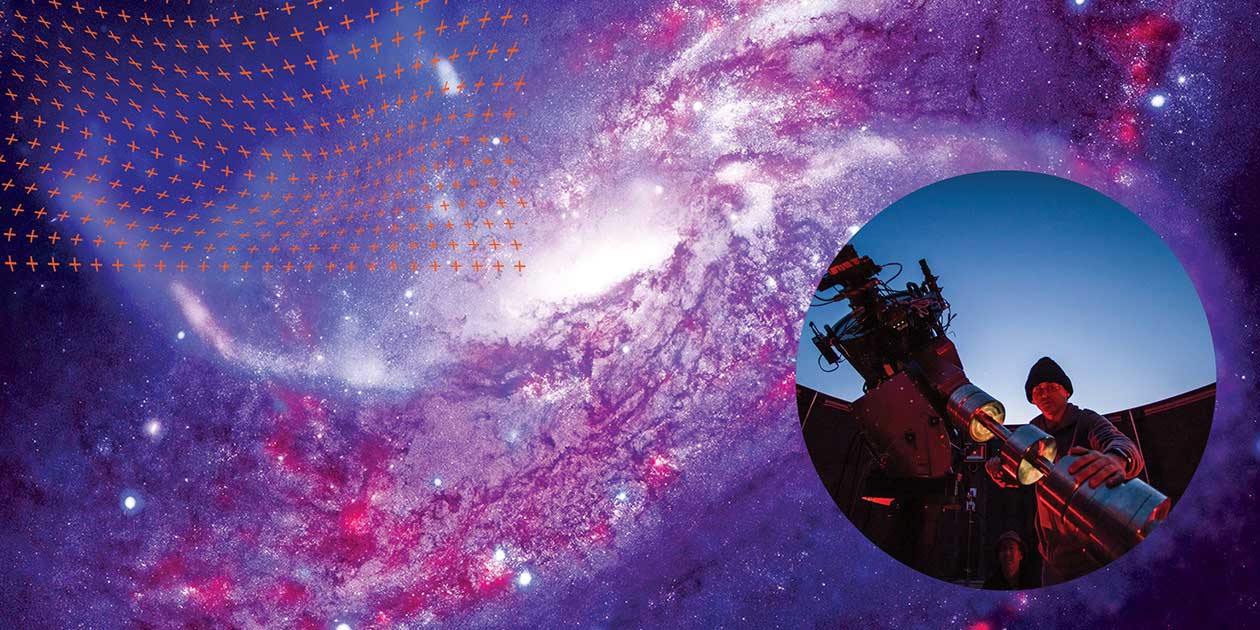
PHOTO: JUSTIN TORNER/UI OFFICE OF STRATEGIC COMMUNICATION
A UI team is teaching computers to categorize celestial objects on their own, then flag for further examination the phenomena that don't fit into neat categories.
Astronomy has a storied history of serendipitous discovery, notes Casey DeRoo (16PhD), UI assistant professor of physics. From Galileo training his telescope on Jupiter's moons for the first time in 1610 to Jocelyn Bell Burnell's discovery of pulsars while searching for quasars in 1967, sometimes the biggest breakthroughs happen by chance.
In that spirit, a UI research team is working to train AI to assist in making similar serendipitous discoveries in the cosmos. Partnering with Liu and under DeRoo's direction, physics and astronomy graduate student Dustin Swarm and undergraduate Samantha Watkins are training computers to comb through massive datasets to identify anomalies like new black holes and neutron stars that haven't previously been scrutinized by scientists.
"AI tools are going to have to be a part of every astronomer's toolkit. If you want to get something out of astronomical data, you need to be able to speak the language of artificial intelligence."— Casey Deroo
The research team is currently analyzing the Chandra Source Catalog, a collection of 300,000-plus space objects documented by the satellite Chandra X-ray Observatory. "There are not enough professional X-ray astronomers in the world to sit down and look at 300,000 sources one by one, let alone perform a detailed analysis of them," DeRoo says, "so we have to make choices about what we're going to spend time analyzing. That's where we look to AI."
Essentially, says DeRoo, the UI team is teaching computers to categorize celestial objects on their own, then flag for further examination the phenomena that don't fit into neat categories. That includes supermassive black holes, pulsars, and other mysterious objects in our galaxy and beyond. With the AI's help, the UI team cataloged 119 outliers in the Chandra data set that are worthy of in-depth study and could potentially yield new discoveries.
The problem of how to analyze the enormous amounts of data being generated by observatories is a pressing one in astronomy. The Chandra X-ray dataset examined by the UI team, for example, amounts to about 50 gigabytes of information gathered over the past two decades. But DeRoo says that in the coming years, new observatories will come online that will generate that much data each day.
"This is really the direction the field is going," DeRoo says. "AI tools are going to have to be a part of every astronomer's toolkit. If you want to get something out of astronomical data, you need to be able to speak the language of artificial intelligence. These cross-disciplinary studies at the IIAI are helping make that happen."
2. ACCELERATING LOW-COST COVID-19 TESTING
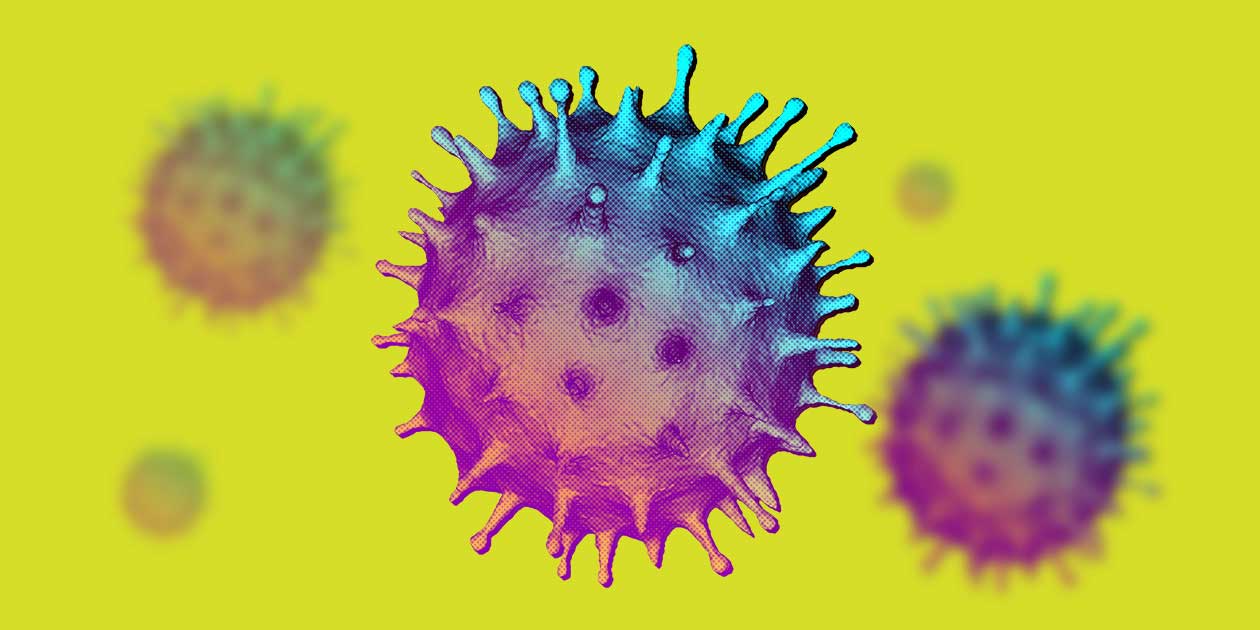
The pandemic has paralyzed the world for nearly a year, but a UI research team is hoping AI can be used to improve the large-scale testing needed to slow the spread of COVID-19.
"Public health experts believe that mass virus and antibody testing is essential to stopping the spread of the COVID-19 virus and enabling a safe and fast transition to normal social life," says Weiyu Xu, associate professor in the Department of Electrical and Computer Engineering. "However, current testing capacity is limited, and there is often a shortage of reagents needed for performing tests."
Given this urgent need to increase testing capacity globally, Xu and fellow UI researcher Raghu Mudumbai are studying how what's called "compressed sensing technology" can be used to produce fast COVID-19 testing results without sacrificing accuracy. Simply put, the idea is to pool patient samples together for a single test, then use the technology to determine which of the samples contained the virus. This could expedite testing tenfold, the researchers say.
After receiving a $150,000 Rapid Response Research grant from the National Science Foundation this past summer, the researchers have completed their initial experiments and are in the process of submitting and publishing their results. They are also collaborating with the State Hygienic Laboratory at the UI and other labs to begin clinical applications of their COVID-19 testing technology.
3. UNDERSTANDING ONLINE POLITICAL RADICALIZATION
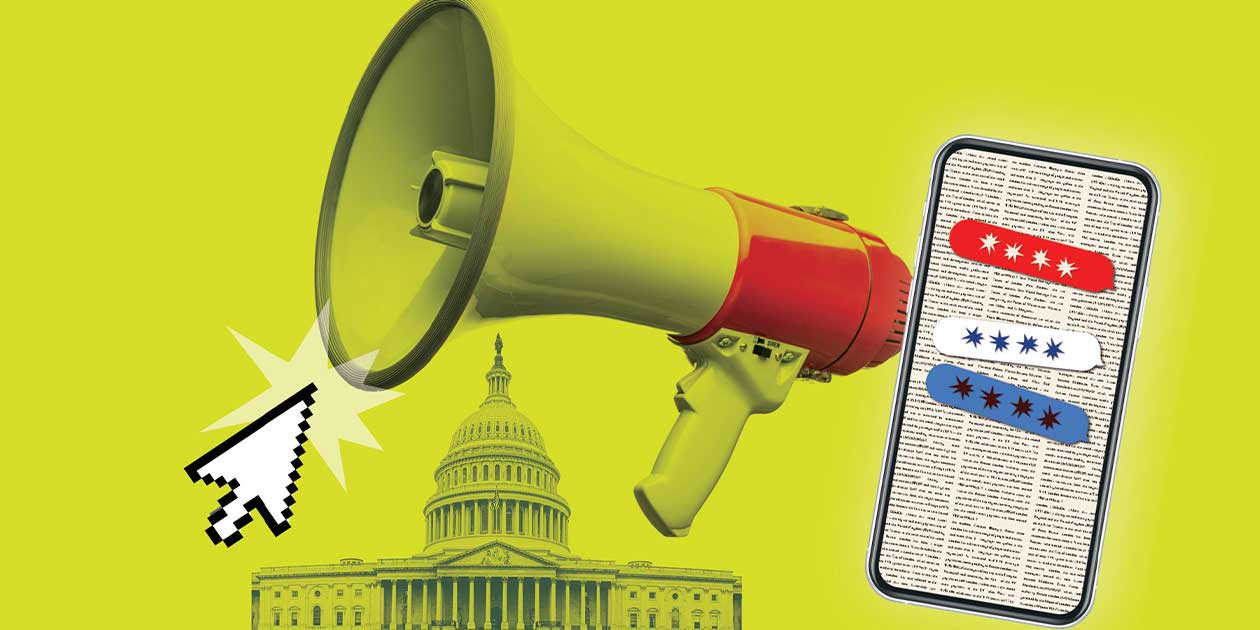
Anytime you click, like, share, read, watch, and comment on a social media platform like Facebook or YouTube, an invisible algorithm queues up your next video or meme. This personalization of the experience can create "reinforcing spirals," experts say, in which a user's media choices affect their interests, which in turn, affect their future media choices. In other words, it's a feedback loop.
UI researchers are investigating whether such feedback loops contribute to political radicalization. "While online radicalization has been a concern for a number of years, the explosive growth of social media over the past 10 years, combined with growing political polarization and the collapse of trust in news media institutions, has led to growing fears and reports of social media radicalization," says UI communications studies professor Tim Havens.
Those fears, says Havens, were amplified by the mass murders at a synagogue in Pittsburgh in 2018 and a mosque in New Zealand in 2019. Both atrocities were allegedly perpetrated by individuals radicalized on social media.
"The explosive growth of social media over the past 10 years, combined with growing political polarization and the collapse of trust in news media institutions, has led to growing fears and reports of social media radicalization."—Tim Havens
Havens, along with assistant computer science professor Rishab Nithyanand and associate journalism and mass communication professor Brian Ekdale, have partnered with the IIAI on the project. The team received a $1 million grant to conduct the study from the Minerva Research Initiative, a social science research program sponsored by the U.S. Department of Defense.
Using computational methods, quantitative surveys, and in-depth interviews, the research group aims to better understand how political radicalization occurs online and provide tools for social media platforms to identify and combat radicalization.
"Most research to date on social media radicalization has focused on the general population, but in our study, we look specifically at vulnerable populations," Havens says.
To that end, the group is using machine learning to study online communities susceptible to radicalization. The researchers are constructing and training a computer model of community evolution based on subreddits that have been banned by the popular website Reddit for violating site policies concerning extremist content. That model can then be applied to other online communities to predict those that are likely to adopt extremist ideologies based on previous behavior.
The team will soon begin recruiting potentially vulnerable individuals, identified through a survey, for a longitudinal study to see how both online and offline influences shape their political beliefs moving forward. Down the road, researchers will test tools to predict future radicalization potential based on both personal attributes and attributes of social media community evolution.
"As a group, we've always confronted and worked through different disciplinary assumptions, vocabularies, and blind spots in our research designs," says Havens, whose research team began as an Obermann Center for Advanced Studies working group on algorithms and social media. "We believe that this grant is a testament to the hard work we've put in cultivating this kind of truly interdisciplinary community."
4. FORECASTING AND MITIGATING FLOODS
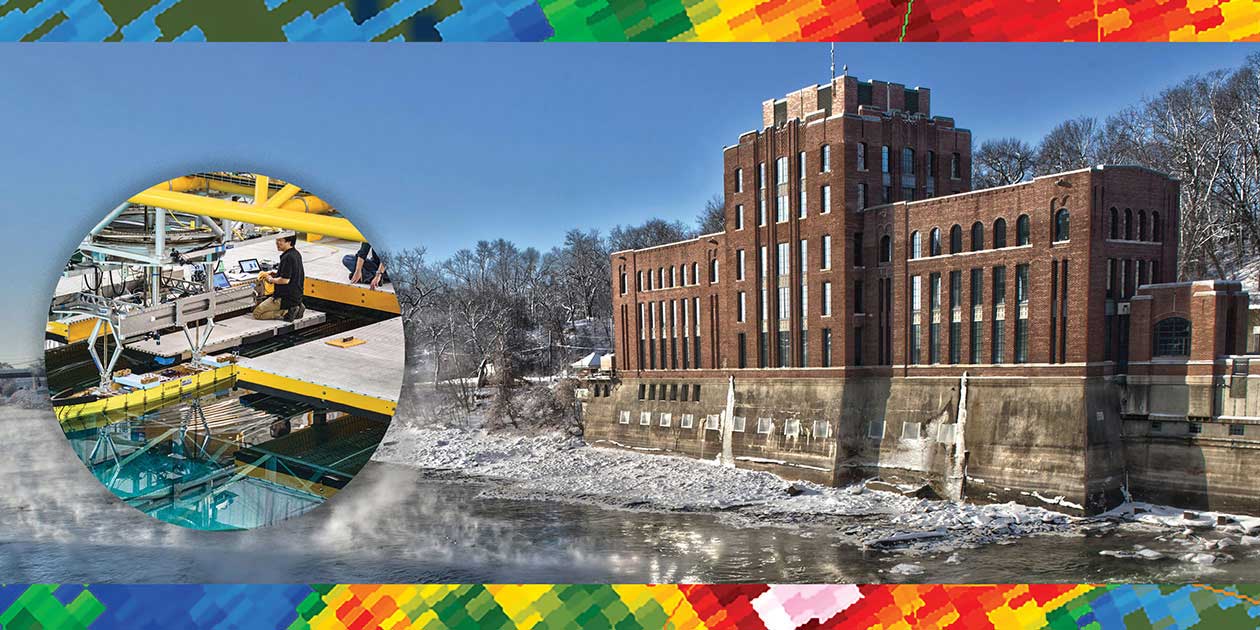
IIHR PHOTO: TIM SCHOON/UI OFFICE OF STRATEGIC COMMUNICATION; HYDRAULIC LAB PHOTO: JUSTIN TORNER/UI OFFICE OF STRATEGIC COMMUNICATION
The UI's C. Maxwell Stanley Hydraulics Laboratory and Hydraulics Wave Basin Facility (inset photo)
Few communities understand the dangers of flooding better than Iowa City. In 2008, the Iowa River overflowed its banks, inundating dozens of campus facilities and causing an estimated $750 million in damage. Soon after, the state legislature established the Iowa Flood Center, which is operated by the UI College of Engineering's IIHR—Hydroscience & Engineering.
Building upon that expertise, UI engineers are applying artificial intelligence techniques to forecast and mitigate future floods. Researchers are using machine learning to predict downstream flowrates at critical locations in a river network, then using that data to determine when it's best to open and close dam gates to reduce the river's peak flowrate.
The team is also exploring new alternatives for flood protection. Traditionally, flooding is mitigated by the construction of large dams upstream of cities and other vulnerable locations. Dams, however, are costly to build and manage, they're prone to catastrophic failure, and the topography of an area can present challenges.
UI researchers are proposing a new, more flexible approach to flood control that would protect multiple locations instead of just one urban center. The idea is to create thousands of small water storage structures throughout the river basin—specifically earth dams and wetlands—then use AI to control the outlets in those retention systems.
Using a physics-based mathematical model that calculates rainfall uncertainties, the researchers are training a neural network to predict water levels in real-time using data generated from massive computer simulations. Ultimately, the proposed dams and wetlands could be controlled using AI algorithms to hold and release water in a way that minimizes the potential for flooding at multiple locations throughout the river network. Preliminary studies have shown that flood mitigation in a small river network can be achieved through this approach.
Shaoping Xiao, UI associate professor of mechanical engineering, says his team is using the Turkey River basin in northeastern Iowa as the virtual test bed to develop and validate their AI model. Having successfully developed their network architecture and model framework, Xiao and his colleagues are currently testing the computer model with different input variables.
The research team includes Ricardo Mantilla, assistant professor of civil and environmental engineering, and graduate students Avinash Mudireddy and Faruk Gurbuz. Xiao says the IIAI has been instrumental in providing the technical support, expertise, and GPU-based computers needed to develop the neural network.
"AI, accompanied by data analytics, has been widely used in every engineering discipline, from manufacturing novel engineering materials to designing self-driving cars," Xiao says. "It has been the third tool, in addition to experiments and computational modeling, in science and engineering. AI plays a critical role in the current Fourth Industrial Revolution."
5. FIGHTING CANCER WITH A POWERFUL NEW ALLY
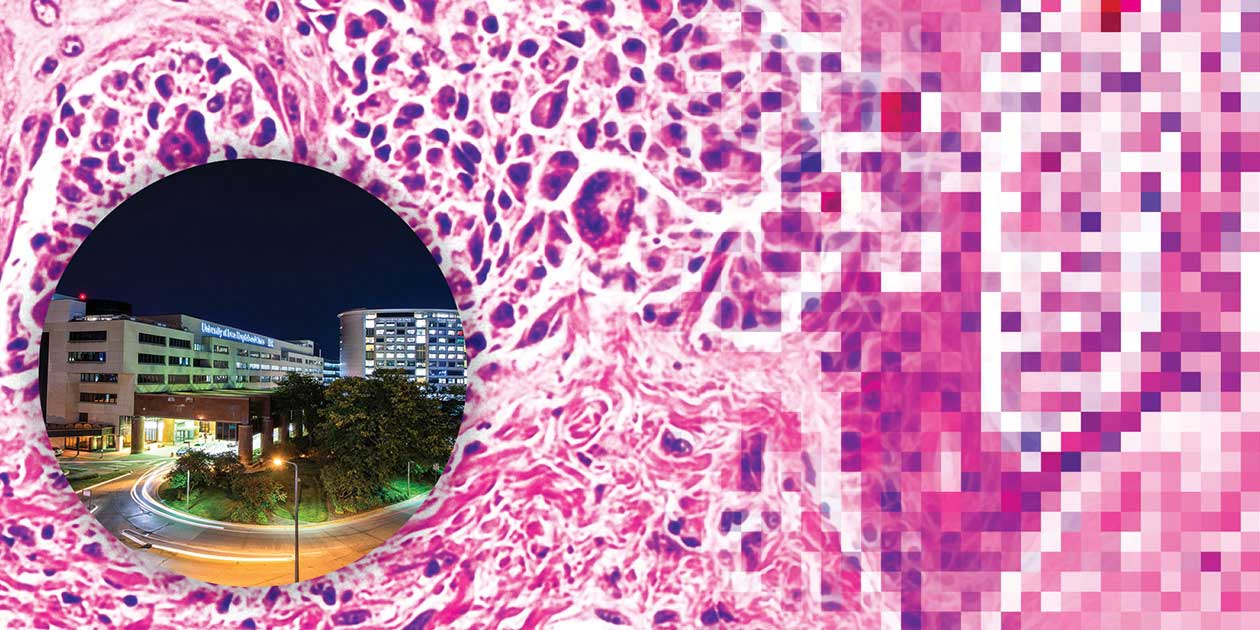
PHOTO: JUSTIN TORNER/UI OFFICE OF STRATEGIC COMMUNICATION
UI researchers have examined how AI can be used to identify which patients with malignant melanoma tumors will respond to treatments.
Home to Iowa's only comprehensive cancer center, the UI is a leader in not only patient care, but also in researching new ways to prevent, detect, and treat cancer in its many forms. Now researchers at the UI Holden Comprehensive Cancer Center are turning to a new ally in the fight: artificial intelligence. Several current research projects are underway in partnerships between Holden researchers and the IIAI, including promising studies in melanoma, breast cancer, and tumor recurrence.
In the first project, David Kuehn (87BSE, 92MD, 96R), clinical associate professor of radiology, and Jinha Park, a former UI professor of radiology, have examined how AI can be used to identify which patients with malignant melanoma tumors will respond to treatments. The hope is that through software tools that can learn from past imaging data, AI will be capable of assessing CT scans and guiding oncologists on a course of treatment. The researchers believe that by better predicting treatment outcomes, AI will not only decrease the number of patients who undergo ineffective treatments, but also lessen overall health care costs and minimize some side effects. They're also exploring how the software can be applied to other areas of cancer care research.
In a separate project, Robert Cornell, professor of anatomy and cell biology, is leading a research team that's investigating how machine learning can help improve the estimates of familial risk for breast cancer and increase the understanding of the biological underpinnings of the disease.
The IIAI is also partnering with Yusung Kim, clinical professor of radiation oncology, to study how AI can be deployed to predict tumor recurrence in patients. As many as 25 percent of patients with non-small cell lung cancer treated with radiation therapy have tumors that recur within five years of treatment, but Kim's team is working to develop algorithms that reliably predict tumor recurrent lesions and provide an accurate survival outcome for a patient.
Meanwhile, a multidisciplinary team comprised of Jesus Gonzalez Bosquet, Xiaodong Wu, Hui Xie, Douglas Russo (19MD), and Maheen Rajput (05R, 06F, 07F) is working to develop a new AI diagnostic tool that can objectively identify ovarian cancer early and before surgery. The team of medical and engineering experts aims to create a machine-learning based prediction model that will discriminate which patients with pelvic masses diagnosed by CT scans are suffering from ovarian cancer.
"Ovarian cancer is a leading cause of cancer death among women in the United States, due in large part because most patients present with advanced disease at diagnosis," the researchers wrote in a project proposal. "Despite considerable efforts for early diagnosis and/or screening, to date there is no valid diagnostic tool capable of identifying ovarian cancer before it becomes symptomatic and disperses outside the pelvis."
